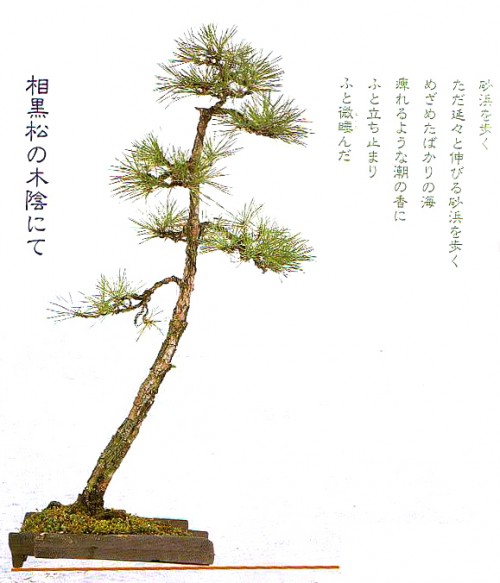Bunjin Black pine from an article entitled ‘The Use of Unusual Pots‘ in Bonsai Today issue 31. The article shows how you can make unconventional pots (like the one above) using ceramic tiles, wire & glue.
Bunjin
Bunjin (aka literati) bonsai are marked by delicacy, grace and for some, the feelings they evoke, with their long narrow trunks, spare branching and sparse foliage. Sometimes you’ll see trees that have some bunjin characteristics, but with perhaps a heavier than usual trunk, or thicker foliage. In this case, there’s no doubt it’s a bunjin; the trunk is long and narrow, their are only a handful of branches, and the foliage is very light.
Win a free pair of Koyo Satsuki bonsai shears
I’d like to know what you think this of this bunjin. What you like or don’t like about it. Or perhaps something about how you would improve it and why. Or why you would leave it just as it is. Or….? I have my opinions, but I’d be interested in hearing yours. So interested in fact, that I’d like to offer at least one of you a free pair of Koyo high-carbon-steel Satsuki bonsai shears (or comparable shears of your choice) for your answer.
Don’t post your answer in the comments…
…unless you want to be at a disadvantage. Send it to wayne@stonelantern.com, with Bunjin as the subject line.
Disclaimer
If you are unhappy in any way with how the contest is run, or the results, or anything else; just remember that it’s just for fun, I’m human, and, best of all, it’s free.
Good news!
Speaking of Japanese black pines, our famous pine book is going to be back in print soon. You can save $5.00 if you order and prepay now.

I really like these type of bonsai. I have some young ones just starting with. I think I would like to lean it to the right just a little more and if possible try and bring the 1st right branch up and the 2nd down to help with the open space that seems to be there. I think that would help with the space in between them. Or if its possible take what looks like the 3rd branch on the right off so the spacing would continue up the right side incrementally.
(If you understand what I am trying to say). But that being said who wouldn’t like to have this tree.LOL I also would like to hear your opinion on this one as well.
Thanks,
Bob Y
I took a while to look at this image and felt that something was either missing not quite right. As a Bonsai it is fine although for my liking the needles are a little too close to the trunk (2nd and 3rd branches) hiding it too much. (maybe too big ?)
It finally came to me that it was the size of the tree that bothered me. It looks either too small for the foliage it has or if it is a tall tree then it is a little unbalanced. It has the feel of being a very young tree.
Of course the image can only offer so much information and seeing the tree ‘live’ would change my opinion completely no doubt.
Would I have such a tree in my collection – absolutely, however the hot South Australian sun and scorching north winds would be an issue as it does not have much soil to store moisture.
I have a Radiata Pine (Monterey or Insignis Pine elsewhere across the world) in my collection that I field dug several years ago that may lend it self to this style so we shall see what the future now holds given this Bonsai Bark has offered a possible idea to me.
Cheers from down under,
Alan…
Bonsai art, as in life, exhibits more beauty with age (or the appearance of age). This bunjin is beautiful as a package – pot, tree and all. It’s height, the sparseness of its branches and the rugged bark all lend to its appearance of being old – having seen some rough times. The pot adds to that artistic impression and gives this bunjin an added dimension. Being from America, it reminds me of the trees found in mountainous areas of the west. Very nice bonsai. I often have to fight the part of me that always wants symmetry. But, artistic impression in bonsai often challenges us to go beyond that. There were some areas that I might have impulsively changed, but after looking at it more, I would leave it as is … okay, maybe let the bottom branch gain a few more needles.
Hi Tom,
Thanks for your thoughtful comments and agreed particularly about trees in the mountains of the western US. The Rockies, Sierras and Cacades are treasure troves of potential bonsai. Not that I’m recommending willy-nilly collecting.